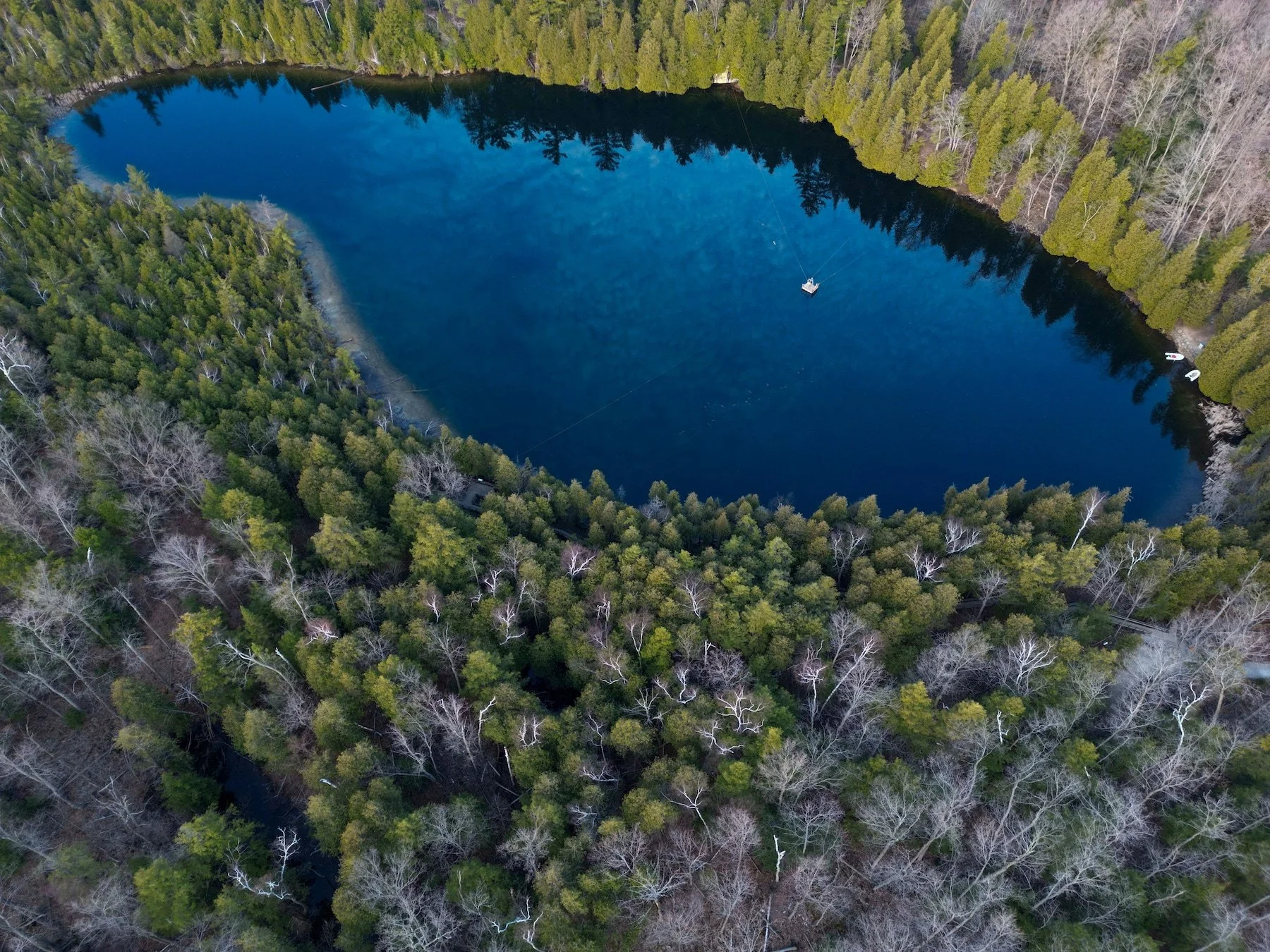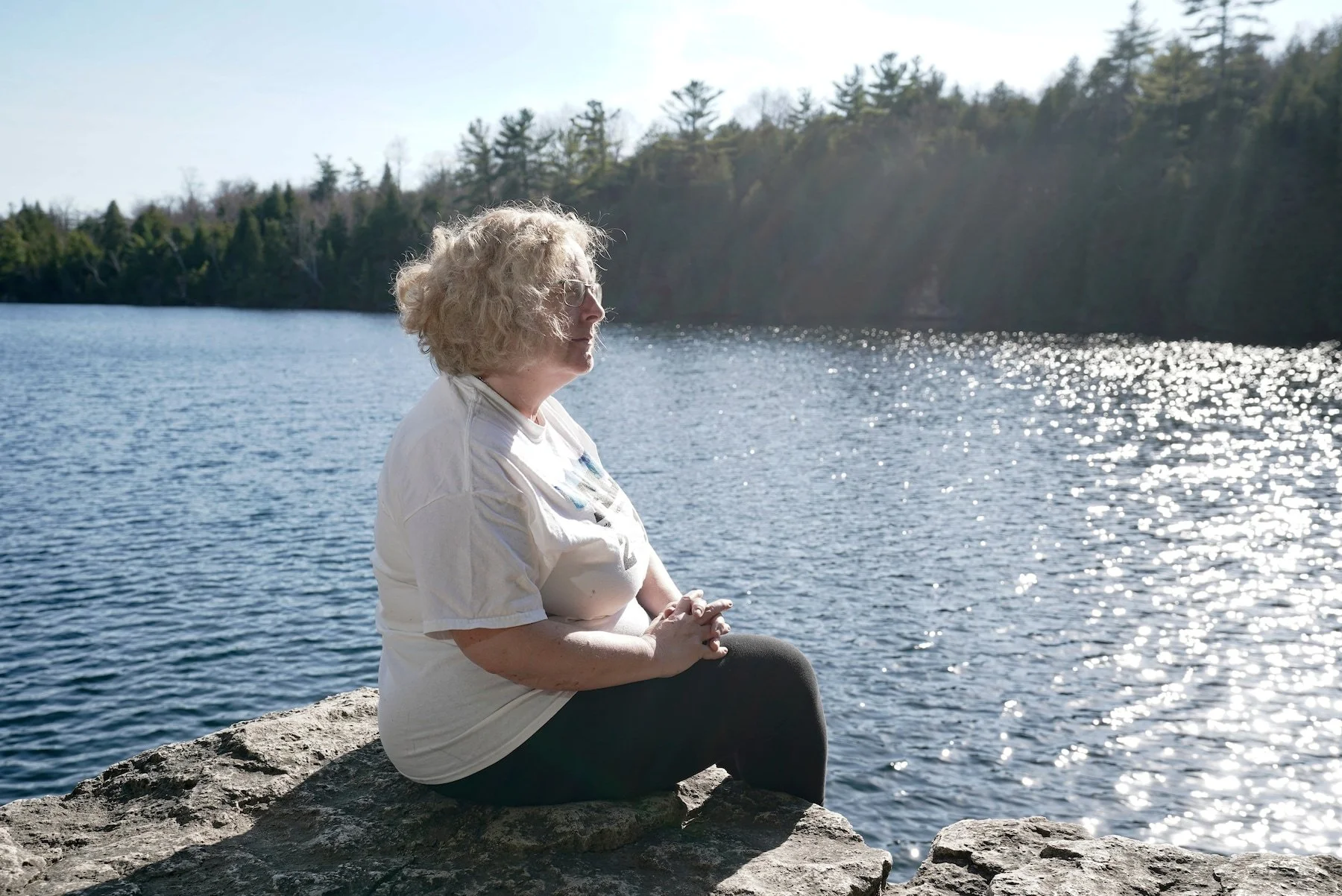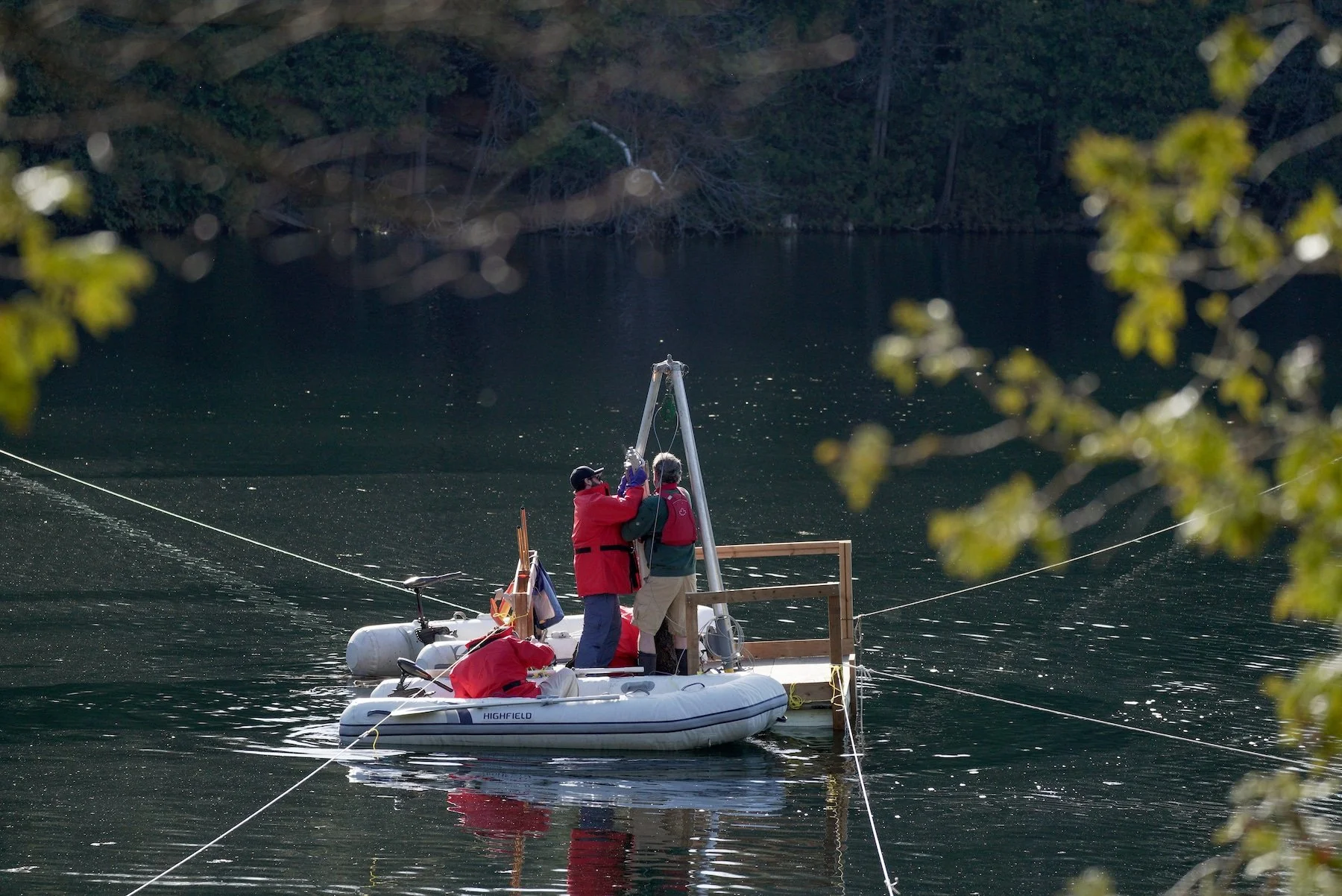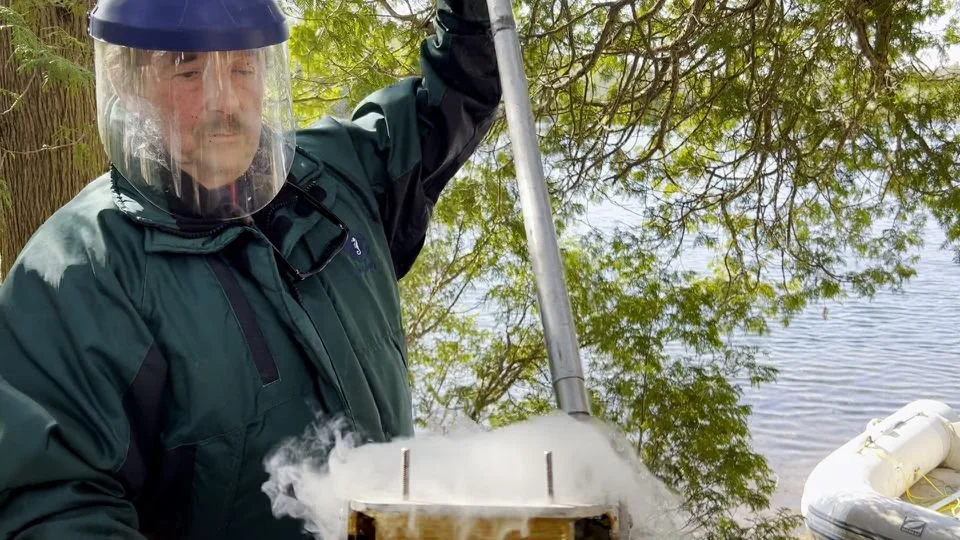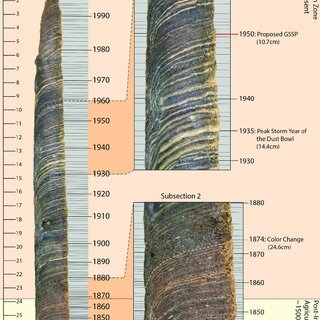HIDDEN BENEATH THE SURFACE
Digging deep into a humble lake in Canada, scientists found a spot on Earth like no other — and a record that could redefine our history of the planet.
Locals used to say that Crawford Lake was bottomless. It’s waters ran deeper than people could reach. Anything that dropped into the basin, it seemed, would fall to the end of time.
Yet when scientists finally looked into the murky depths, they found not a void, but a mirror.
For centuries beyond memory, Crawford Lake has quiety absorbed signs of change from the surface world.
Whatever fell into the water would drift down to the lake floor.
There it was permanently preserved in layers of mud.
Digging into these sediments, scientists have undercovered a record of more than a thousand years of history. It shows - perhaps more than anyplace on Earth - that humans have transformed the planets chemistry and climate at a pace never seen before.
These changes are so fundamental, many scientists believe they mark a new chapter in geologic time:
The Anthropocene.
This summer, researchers will determine whether Crawford Lake should be named the official starting point for this geologic chapter, with pollution-laden sediments from the 1950s marking the transition from the dependable environment of the past to the uncertain new reality humans have created.
In just seven decades, the scientists say, humans have brought about greater changes than they did in more than seven millennia. Never in Earth’s history has the world changed this much, this fast. Never has a single species had the capacity to wreak so much damage — or the chance to prevent so much harm.
“It’s a line in the sand,” said Francine McCarthy, a professor of Earth sciences at Brock University in Ontario, who has led research on Crawford Lake. “The Earth itself is playing by a different rule book. And it’s because of us.”
Seeking the golden spike
Every new phase of Earth’s history begins with a “golden spike” — a spot in the geologic record where proof of a global transformation is perfectly preserved.
An exposed Tunisian cliff face bearing traces of an ancient asteroid impact marks the transition from the age of the dinosaurs to the Cenozoic era. Hydrogen molecules uncovered in Greenland’s ice denote the start of the Holocene — the 11,700-year stretch of stable temperatures that encompasses all of human civilization, up to and including the present day.
These spikes are like exclamation points in the story of the planet, punctuating a tale of shifting continents, evolving species and temperatures that rose and fell as carbon levels fluctuated in the atmosphere. They mark the starts of epochs — small segments of geologic time. And they have helped scientists interpret the forces that shaped Earth’s past climates, which in turn allows them to forecast the effects of modern warming.
In 2009, the International Commission on Stratigraphy — an obscure scientific body responsible for defining the phases of Earth’s past — created a new working group to investigate the evidence for the Anthropocene. The group’s mission: to identify a potential “golden spike” site that might convince fellow scientists of the new epoch’s validity.
Their search spanned from mountain summits to the depths of the ocean, from the Antarctic ice sheet to tropical coral reefs. And, in 2018, it led them to McCarthy’s office door.
Before that moment, few beyond her field knew of McCarthy’s research studying lake sediments for signs of past climate change. Her outreach work was meaningful, but largely local: advocating for conservation of the Great Lakes, teaching geology to students at her midsize public university.
Crawford Lake was similarly modest — just a pretty little pool at a park in the Toronto suburbs. Schoolchildren liked to visit its reconstructed Indigenous longhouses. Locals treasured it as a quaint spot to have a picnic and watch for birds.
Yet McCarthy’s colleague Martin Head, a geologist at Brock who had been involved with the Anthropocene Working Group, was intrigued by the rare chemistry uncovered at Crawford.
Crawford Lake developed thousands of years ago, as water filled a sinkhole in the limestone cliffs of Southern Ontario.
Though tiny, the lake is eceptionally deep. So deep it’s waters are seperated into two distinct layers.
Upper waters are warmed by sun, and mixed by wind.
The layer below is cold and dark, with barely any life to disturb the sediments that accumulate on the bottom.
All year long, a constant stream of dead microbes, animal droppings and other organic debris drifts through Crawfords waters to settle on the lake bed.
But during summer, when the temperatures and acidity levels are just right, the waters also produce crystals of a white mineral called calcite that fall to the lake bed, forming a thin white cap.
Each annual pair of dark and light sediments is also laced with material from outside the lake - pollen grains, pollution particles - that can serve as indicators of the changing environment.
Meanwhile, groundwater trickles through the pockmarked limestone around the lake, delivering oxygen to its depths. This prevents chemical interactions that could affect important environmental markers.
No other water body is known to possess this particular combination of attributes, making Crawford Lake a unique bellwether of global change.
“It’s a freak of nature, but it’s my little freak of nature,” McCarthy said. “And it’s perfect for what we need.”
As she considered her colleague’s proposal, McCarthy thought about the decades she’d spent studying prior planetary upheavals. Her work on lake sediments from the past several million years had shown her how dramatic swings in temperature destabilized ecosystems and drove species to extinction.
Without drastic action to stave off modern climate change, she said, that history could repeat.
The diary of the Earth
McCarthy on the shore of Crawford Lake, watching the April breeze ruffle the water surface, waiting for work to begin.
First, researchers had to tether a wooden raft in the deepest part of the lake, right over the spot they wanted to sample.
To extract the lake’s layered sediments, the team used a tool called a “freeze corer,” but more affectionately known as “the frozen finger.” The long aluminum wedge was filled with a mixture of alcohol and dry ice, making it much colder than the surrounding water, soil and air.
They suspended the freeze corer from a tripod and lowered it through a hole in the raft. Down, down it went, through 75 feet of water, until finally it sank into the squishy mud on the lake bottom.
Then they waited. It would take about 40 minutes for the lake sediments to freeze onto the corer’s chilly surface.
Finally, it was time to pull the corer back up. Clinging to its face was a five-foot slice of mud, cut from the lake bottom like a piece from the center of a cake.
Back on shore, McCarthy traced a gloved finger over the core’s delicate brown and white stripes — sharper than any other sample she’d seen.
She had uncovered dozens of Crawford Lake cores by that point — but every extraction felt special, and strangely intimate. Each sample, she knew, would give her a glimpse into a thousand years of the lake’s history, revealing its deepest responses to the changing world above. Each was like a new page from the diary of the Earth.
What secrets would she find inside?
The archive inside Crawford Lake’s cores shows how human pressures on the lake built up over the centuries like steam inside a kettle, until finally the kettle boiled over.
But humanity’s influence hasn’t always been so destructive. The first people to make their mark on the lake were Native villagers who built longhouses near the lakeshore. Researchers have counted more than two centuries’ worth of sediments from the lake’s “Indigenous period” containing crop pollen and other evidence of human habitation alongside ancient goose droppings and traces of trees.
Around the start of the 16th century, all signs of the settlement vanished for reasons still unknown. Yet the seasonal process that built the lake’s layers remained.
Sediments from subsequent eras showed Europeans’ growing influence on the landscape. White pine pollen counts dwindled as people cut down trees. Traces of ragweed marked how different species flourished in the cleared land.
The impacts piled up throughout the 19th and 20th centuries. Tiny black bits of fly ash — a byproduct of burning coal and oil — drifted into the lake from rapidly industrializing cities. Heavy metals like copper and lead increased in the mud.
And then, around 1950, the world reached a tipping point.
“This is when humans essentially overwhelmed the Earth as a functioning system,” said Head, McCarthy’s collaborator. Crawford Lake — and the rest of the planet — were fundamentally, irrevocably transformed.
The sharpest sign of change was a surge in radioactive plutonium that started in Crawford Lake’s mud around 1950. The element rarely occurs naturally on this planet; it could only have come from nuclear weapon tests happening thousands of miles away.
Other shifts weren’t necessarily new, but they appeared at scales ten or a hundred times greater than anything the lake had seen before. A lighter form of nitrogen — a molecular signature of burning fossil fuels — proliferated. The amount of fly ash increased eightfold in less than five years. Acid rain, caused by pollution reacting with water in the atmosphere, diminished the calcite layers.
Still more sediments recorded irreversible losses. Certain microbe species were eliminated locally. The amount of elm pollen plummeted — a consequence of the invasive fungus that was decimating North America’s tree populations at the time.
All the while, greenhouse gas pollution made the planet inexorably hotter. The lake’s calcite layers became thicker during warm years; pollen grains show how the forest composition shifted to include more heat-loving tree species.
Average temperatures in southern Canada have increased about 1.5 degrees Celsius (2.7 degrees Fahrenheit) in this time. The globe as a whole is now warmer than it’s been at almost any point since the end of the last ice age.
These changes all are the result of what scientists call “the Great Acceleration” — the dramatic, simultaneous surge in almost every measure of human activity that started in the mid-20th century and continues through today.
The same evidence appears all over the planet, in every potential golden spike site the Anthropocene Working Group has examined. Peat bogs, ocean basins, the skeletons of coral reefs — even the ice of Antarctica has been permanently tainted by human pollution.
“What we have measured, in a very objective and quantitative way, is we are living in a world with conditions that are no longer within the last 11,000 years of natural variability,” McCarthy said. “The Earth is, in fact, fundamentally different.”
‘Where we have a story to tell’
When the last core samples were taken from Crawford Lake this spring, Catherine Tammaro couldn’t bring herself to watch.
To the Wyandot artist and faithkeeper, who is descended from the people who likely once lived here, the lake is a living being. She calls this space “Kionywarihwaen” — a Wendat name meaning “where we have a story to tell.”
And Crawford Lake had already endured so much painful history. Dredging up its sediments — even for science — felt like another invasion.
But after hours of reflection alongside representatives from other First Nations, Tammaro had come to agree that the coring should go forward.
“It’s like a surgical operation,” she said. “It’s painful, but we recognize that it should be done … because it may help prevent further climate disaster by adding to our understanding of how humans have had an impact on the Earth.”
The extraction of this core was one of the last steps before the Anthropocene Working Group selects its preferred “Golden Spike” site, a decision that is expected this summer. Crawford Lake is considered a top candidate for the recognition.
Before the Anthropocene — and the lake — can claim a place in geologic history, the proposal must undergo several more rounds of voting. And not all geologists are convinced the Anthropocene belongs on Earth’s 4.6-billion-year timeline. Some say this period of overwhelming human influence has been too brief to know whether it is truly an epoch, a span that typically lasts millions of years. Others have pointed out that — unlike the asteroid impact that killed the dinosaurs and other epoch-defining events — human-caused changes didn’t happen simultaneously all around the world.
“Formalizing the Anthropocene creates a hard and bright line, and you either exist on one side or the other,” said Jacquelyn Gill, a paleoecologist at the University of Maine. “But really, it’s been a long gradient, a long process of changing how we live.”
I could not post the Washington Post graphics of the cores, showing better detail of the lines and dates. These were what I could find on google.


